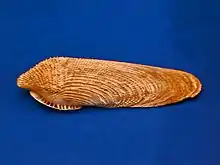Pholas dactylus
Pholas dactylus, or common piddock, is a bioluminescent clam-like species of marine mollusc found on the coasts of the North Atlantic and the Mediterranean Sea. It bores into gneiss. It was once a highly esteemed food in Europe.[2][1]

| Pholas dactylus | |
|---|---|
 | |
| Shell of Pholas dactylus from Sicily on display at the Museo Civico di Storia Naturale di Milano | |
| Scientific classification | |
| Kingdom: | Animalia |
| Phylum: | Mollusca |
| Class: | Bivalvia |
| Order: | Myida |
| Family: | Pholadidae |
| Genus: | Pholas |
| Species: | P. dactylus |
| Binomial name | |
| Pholas dactylus | |
| Synonyms[1] | |
| |
It is sensitive to light, retracting into its shell when exposed to it.[3]
Ancient history
Pliny spoke of luminescence in the mouths of people who ate Pholas, the rock-boring shell-fish, and of such importance is this phenomenon that it is even said to have gained the first king of Scotland his throne.[4] Hippolytus of Rome tells us that it was a common pagan trick to use the luminescent property of this clam to create the illusion of burning, "And they accomplish the burning of a house, by daubing it over with the juice of a certain fish called dactylus."[5]
References
- Gofas, S. (2012). Pholas dactylus Linnaeus, 1758. Accessed through: World Register of Marine Species on 2012-02-23
- "Pholas dactylus (clam) - Britannica Online Encyclopedia". Britannica.com. Retrieved 2011-09-24.
- Selig Hecht (1927). "The kinetics of dark adaptation". The Journal of General Physiology. 10 (5): 781–809. doi:10.1085/jgp.10.5.781. PMC 2140923. PMID 19872361.
- Author: Field Naturalists' Club of Victoria, Volume: v.21, 1904-1905, Subject: Natural history; Natural history, Publisher: [Melbourne] Field Naturalists Club of Victoria, Year: 1884, Possible copyright status: NOT_IN_COPYRIGHT, page 93
- Author: Hippolytus of Rome, Refutation of All Heresies Book IV, Chapter XXXI.